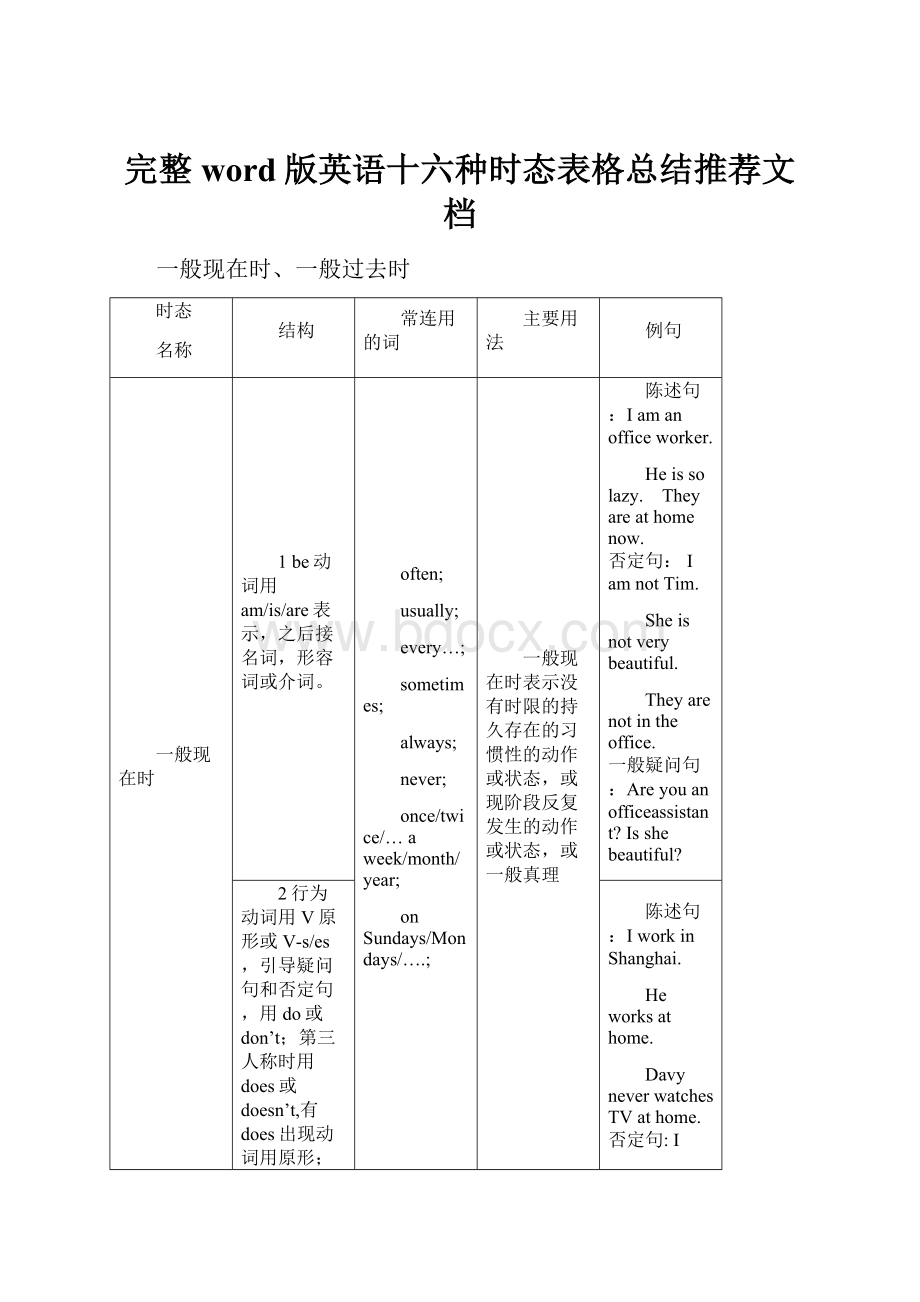完整word版英语十六种时态表格总结推荐文档.docx
《完整word版英语十六种时态表格总结推荐文档.docx》由会员分享,可在线阅读,更多相关《完整word版英语十六种时态表格总结推荐文档.docx(19页珍藏版)》请在冰豆网上搜索。

完整word版英语十六种时态表格总结推荐文档
一般现在时、一般过去时
时态
名称
结构
常连用的词
主要用法
例句
一般现在时
1be动词用am/is/are表示,之后接名词,形容词或介词。
often;
usually;
every…;
sometimes;
always;
never;
once/twice/…aweek/month/year;
onSundays/Mondays/….;
一般现在时表示没有时限的持久存在的习惯性的动作或状态,或现阶段反复发生的动作或状态,或一般真理
陈述句:
Iamanofficeworker.
Heissolazy. Theyareathomenow.
否定句:
IamnotTim.
Sheisnotverybeautiful.
Theyarenotintheoffice.
一般疑问句:
Areyouanofficeassistant?
Isshebeautiful?
2行为动词用V原形或V-s/es,引导疑问句和否定句,用do或don’t;第三人称时用does或doesn’t,有does出现动词用原形;第三人称陈述句V后加s或es.
陈述句:
IworkinShanghai.
Heworksathome.
DavyneverwatchesTVathome.
否定句:
Idon’tlikethefoodinKFC.
Davydoesn’tlikethefoodinKFCeither.
一般疑问句:
Doyouwantacupofcoffee?
Doesshelivenearthesubwaystation?
一般过去时。
1.be动词用过去式was或were表示。
yesterday;
thedaybeforeyesterday;
lastweek/month/year/….;
…ago;
amomentago;
justnow;
on/in+过去的时间;
在过去时间里所发生的动作或存在的状态。
陈述句:
Iwasabigboss.Hewasbeautiful.
WewereinBeijinglastyear.
否定句:
Iwasnotathomeatthatmoment.
Wewerenotatworkyesterday.
一般疑问句:
Wereyouateacher?
Wassheintheofficelastweek?
2行为动词用V-ed,陈述句,疑问句和否定句借助于did,有did出现动词用原形。
陈述句:
IworkedinSunmoon.
WestudiedEnglishthere.HelivedinHongKong.
否定句:
Ididn’tworkhere.
Theydidn’tseeme.ShelikedEnglishalot.
一般疑问句:
DidyougotoAmerica?
DidheworkinSunmoon?
一般将来时、过去将来时
时态
名称
结构
常连用的词
主要用法
例句
一般将来时
1任何人称+will+V原形.
tomorrow,
thedayaftertomorrow;
soon;
nextweek/month/year/...;
theweek/month/year/...afternext;
on/in+将来的时间;
in+一段时间;.
即将发生动作或状态。
陈述句:
IwillflytoHongKongtomorrow.
Hewillgowithus.
WewillarriveinShanghainextweek.
否定句:
Iwillneverbelieveyouagain.
Hewillnotcometonight.
Wewillnotbuyacarnextyear.
一般疑问句:
Willyougotherebytrain?
Willhecometomorrow?
Willtheyliveafive-starhotel?
2is/am/are+goingto+V原形,表示计划打算做什么事情。
陈述句:
I’mgoingtogotoHongKongbyair.
否定句:
Wearenotgoingtobuyahousehere.
一般疑问句:
Aretheygoingtochangetheirjobs?
特殊疑问句:
Howareyougoingtotellhim?
过去将来时
was/weregoingto+V原形
多用在宾语从句中
在过去将会发生的动作。
陈述句:
Iwasgoingtobuyacomputer.
Theytoldmethattheywerenotgoingtogoabroad.(间接引语)
否定句:
Iwasnotgoingtobuyacomputer.
任何人称+would+V原形
HesaidhewouldcomeinShanghai.
IsaidIwouldbuyyouacaroneday.
现在进行时、过去进行时
时态
名称
结构
常连用的词
主要用法
例句
现在进行时
is/am/are+V-ing
now;
atpresent;
atthemoment;
Look!
(放在句首);
Listen!
(放在句首);
表示现在(指说话人说话时)正在发生的事情。
陈述句:
I’mwaitingformyboyfriend.
Heisdoingthehouseworkathomenow.
Weareenjoyingourselves.
否定句:
Heisnotplayingtoys.
一般疑问句:
Areyouhavingdinnerathome?
IsTimcookinginthekitchen?
特殊疑问句:
Whatareyoudoingnow?
Wherearetheyhavingameal?
过去进行时
was/were+V-ing
atthattime;
atthistimeyesterday;
at+时间点+yesterday/lastnight;
atthatmoment;
过去一段时间正在发生的事情。
陈述句:
Iwasdoingmyhomeworkatthattime.
Wewerehavingapartywhilehewassleeping.
否定句:
Hewasnotsleepingat11o’clocklastnight.
一般疑问句:
WereyouwatchingTVatthattime?
特殊疑问句:
Whatwereyoudoingatthatmoment?
现在完成时、过去完成时
时态
名称
结构
常连用的词
主要用法
例句
现在完成时
have/has+p.p(过去分词)
already;just;before;
yet(否定句中);ever;never;once/twice/…
for+一段时间;
since+时间点;
since+一段时间+ago;
by+现在时间;
sofar;uptonow;tillnow;untilnow;
recently/lately;
during/over/inthepast/last….
用来表示之前已发生或完成的动作或状态,其结果的确和现在有联系。
动作或状态发生在过去但它的影响现在还存在;也可表示持续到现在的动作或状态。
陈述句:
IhavealreadytoldDavy.Davyhasknownthismatter.
Hehaslivedherefornearly10years.
否定句:
Ihaven’tfinishedmyhomework..
Timhasn’tcomeyet.
Wehaven’theardanynewsabouthim
一般疑问句:
Hasheworkedheresincehecamehere?
特殊疑问句:
Howlonghaveyouworkedinthiscompany?
特别注意:
1.have/hasalwaysbeen+名词/形容词/介词:
总是或一直是什么样子。
。
。
Hehasalwaysbeenagoodfather.
Ihavealwaysbeenbusy.
TheyhavealwaysbeeninAmerica.
2.have/hasgoneto:
去了某地(未归)
HehasgonetoBeijing.
Theyhavegonetothecinema.
3. have/hasbeento:
表示去过或到过某地
IhavebeentoCanada.HaveyoubeentoHongKong?
Wherehaveyoubeen?
Ihaveneverbeenhere.
过去完成时
had+过去分词
过去的过去:
by+过去的时间
(在XX之前,不迟于);
表“过去某动作或时间以前”的时间状语。
动作发生在过去的过去。
陈述句:
HesaidhehadtoldDavy.(间接引语)
HelefttheofficeafterhehadcalledDavy.
Bytheendofthedaywehadsoldover2000tickets.
否定句:
Shehadn’thaddinnerbeforeshewentout.
一般疑问句:
HadshelearntEnglishbeforeshemovedhere?
特殊疑问句:
howmanyEnglishwordshadhelearntbytheendoflastyear?
英语时态举例
SimplePresent
一般现在时
SimplePast
一般过去时
SimpleFuture
一般将来时
句子结构:
主语+V
I study Englisheveryday.
我每天都学习英语.
句子结构:
主语+V-ed
Twoyearsago,I studied EnglishinAmerica.
两年前,我在美国学英语.
句子结构:
主语+will+V.
Ifyouarehavingproblems,I willhelp youstudyEnglish.
如果你在学习英语当中,遇到问题,我将帮助你.
句子结构:
主语+begoingto+V
I’mgoingtostudy Englishnextyear.
我明年将开始学习英语.
PresentContinuous
现在进行时
PastContinuous
过去进行时
FutureContinuous
将来进行时
句子结构:
主语+be+doing
I amstudyingEnglishnow.
我正在学习英语.
句子结构:
主语+was/were+doing
I wasstudying Englishwhen
youcalledyeaterday.
你昨天给我打电话的时候,我正在学习英语.
句子结构:
主语+willbe+doing
I willbestudying Englishwhenyouarrivetonight.
明晚你来的时候,我会正在学习英语.
句子结构:
主语+begoingto+be+doing
I’mgoingtobestudying Englishwhenyouarrivetonight.
同上.
PresentPerfect
现在完成时
PastPerfect
过去完成时
FuturePerfect
将来完成时
句子结构:
主语+have/hasdone
I havestudied Englishinseveraldifferentcountries.
在一些国家,我已经学习了英语.
句子结构:
主语+haddone
I hadstudied alittleEnglishbeforeImovedtotheU.S.
在我搬去美国之前,我已经学习了一点英语.
句子结构:
主语+will+havedone
I willhavestudied everytensebythetimeIfinishthiscourse.
在我完成这个课程的时候,我已经能完成英语时态的学习了.
句子结构:
主语+begoingto+havedone
I’mgoingtohavestudied everytensebythetimeIfinishthiscourse.
同上.
PresentPerfectContinuous
现在完成进行时
PastPerfectContinuous
过去完成进行时
FuturePerfectContinuous
将来完成进行时
句子结构:
主语+have/hasbeendoing
I havebeenstudying Englishfortenyears.
我已经学习英语有十年的时间了.
句子结构:
主语+hadbeendoing
I hadbeenstudying EnglishfortenyearsbeforeImovedtotheU.S.
在我搬去美国之前,我已经学习了十年的英语了.
句子结构:
主语+willhavebeendoing
I willhavebeenstudying Englishforoverthreehoursbythetimeyouarrive.
明晚你来的时候,我已经学习英语3个小时了.
句子结构:
主语+begoingtohavebeendoing
I’mgoingtohavebeenstudyingEnglishforoverthreehoursbythetimeyouarrive
同上.
详细讲解-一般现在时
通常以动词原形表示。
主语为第三人称单数时,用现单三形式。
动词be和have(表示“拥有”)各人称的单数形式为:
第一人称单数 第二人称单数 第三人称单数
Have Have Have Has
Be Am Are is
一般现在时的否定式、疑问式和简单回答形式如下:
动词be与have(表示“拥有”):
否定式直接把not放在动词之后,疑问式直接把动词放在主语之前,见下表:
否定式&疑问式
Be Have Be Have
Iamnot(I’mnot)… Ihavenot(haven’t)… Ami…?
Havei…?
Youarenot(aren’t)… Youhavenot(haven’t)… Areyou…?
Haveyou…?
Heisnot(isn’t)… Hehasnot(hasn’t)… Ishe…?
Hashe…?
动词be的否定疑问式和简单回答:
否定疑问式 肯定回答 否定回答
AmInot(aren’ti)…?
Yes,youare. No,youaren’t
Areyounot(aren’tyou)…?
Yes,Iam. No,I’mnot.
Ishenot(isn’the)…?
Yes,heis. No,heisn’t
动词be与have(表示“拥有”):
否定式直接把not放在动词之后,疑问式直接把动词放在主语之前,见下表:
否定式 疑问式
Be Have Be Have
Iamnot(I’mnot)… Ihavenot(haven’t)… Ami…?
HaveI…?
Youarenot(aren’t)… Youhavenot(haven’t)… Areyou…?
Haveyou…?
Heisnot(isn’t)… Hehasnot(hasn’t)… Ishe…?
Hashe…?
动词have(表示“拥有”)的否定疑问式和简单回答:
否定疑问式 肯定回答 否定回答
HaveInot(haven’ti)…?
Yes,youhave. No,youhaven’t.
Haveyounot(haven’tyou)…?
Yes,Ihave. No,Ihaven’t.
Hashenot(hasn’the)…?
Yes,hehas. No,hehasn’t.
注意:
have作为行为动词则只能按照行为动词的规则变化。
行为动词(以study为例)一般现在时的否定式、疑问式和简单回答(注意要加助动词do/does)
否定式 疑问式
Idonot(don’t)study DoIstudy
Youdonot(don’t)study Doyoustudy
Hedoesnot(doesn’t)study Doeshestudy
否定疑问句式 简单回答(肯定/否定)
DoInot(Don’tI)study…?
Yes,Ido.No,Idon’t.
Doyounot(Don’tyou)study…?
Yes,youdo.No,youdon’t.
Doeshenot(Doesn’the)study…?
Yes,hedoes.No,hedoesn’t.
详细讲解-现在进行时、一般过去时
由助动词be+现在分词构成。
其中be有人称和数的变化,有三种形式:
第一人称单数用am,第三人称单数用is,其他用are。
现在进行时的否定式是:
直接在助动词be后面加上not;疑问式是:
把助动词be提到主语之前。
以study为例:
否定式 疑问式
Iamnotstudying AmIstudying?
Youarenotstudying, Areyoustudying?
Heisnotstudying. Ishestudying?
一般过去时
一般过去时通常由动词过去式表示。
一般过去时的否定式、疑问式和简单回答形式要用助动词do的过去式did,同时注意实义动词要用原形。
以study为例,其否定式、疑问式和简单回答形式如下:
否定式 疑问式
Ididnot(didn’t)study…. DidIstudy…?
Youdidnot(didn’t)study…. Didyoustudy…?
Hedidnot(didn’t)study…. Didhestudy…?
否定疑问式 简单回答(肯定/否定)
DidInot(Didn’tI)study…?
Yes,youdid.No,youdidn’t.
Diyounot(Didn’tyou)study…?
Yes,Idid.No,Ididn’t.
Didhenot(Didn’the)study…?
Yes,hedid.No,hedidn’t.
详细讲解-过去进行时、过去完成时
过去进行时
由助动词be的过去式+现在分词构成。
其中be有人称和数的变化,第一、第三人称单数用was,其他用were.
1)过去进行时动词主要表示在过去某一时刻或某一段时间内正在进行或持续进行的动作。
过去进行时经常与过去时配合使用。
例如:
Thistimeyesterday,wewerehavinganEnglishlesson.昨天这个时候,我们正在上英语课。
TheteacherwasgivingusalessonwhenTomwalkedintotheroom. 老师在给我们上课时,汤姆走进教室。
Whilewewerehavingsupper,allthelightswentout.我们吃饭的时候,灯灭了。
Hewasreadingwhileshewassettingthetable.她摆桌子时,他在读书。
Itwasgettingdark.Thewindwasrising.天渐渐黑下来了。
风势增强了。
2)过去进行时动词常用always,continual